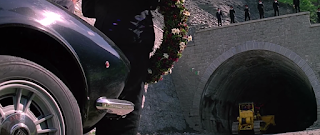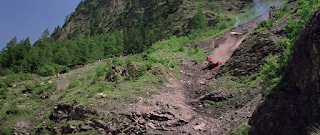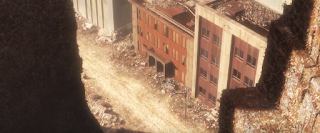Set in the 1970's, The Anchorman (2004) is a comedy based on the story of a hotshot, sexist Anchorman - Ron Burgundy who doesn't believe in women working in the world of broadcast. So when talented journalist Veronica Corningstone begins working alongside Burgundy and out-shining him, Ron begins to grow jealous. After making a vulgar slip on the TV during the dispute rivalry between the two, Ron ruins his career and his fired. However, when a huge news story breaks through, he gets a chance to redeem himself.
Narrative
The opening to this film is conventional of a comedy film because of the use of a narrator voice over, over the top of the helicopter, aerial shots of the city buildings. This narrator sets the scene of the film being set in the 70's, introduces the character of Ron Burgundy, and establishes that the film is also set in San Diego. The things that the narrator says are comedic. The narrative within the opening of this film is mainly a montage, as there are multiple clips on Ron Burgundy getting ready to present the news on TV.
Mise en scene
The first live action shot to the opening scene of The Anchorman is a wide, establishing shot of a city, which the audience later comes to understand is San Diego. It shows tall buildings, a long bridge and the sea. This creates an exciting atmosphere within the first shot of the opening, which is important as these first few shots are vital in the role of incorporating the chosen genre. The lighting is bright and the sky is blue in the background, depicting that the day is sunny. This mise en scene within the first shot incorporates the notion that the film will be fun, as sunshine and brightness connotes ideas of this.
The narrator then says, after explaining the world of news, "and in San Diego, one anchorman was more man than the rest. His name was Ron Burgundy." After he says this the music changes and a there's a low, close up shot of just this character's foot stepping out of the helicopter. The mise en scene of this shot is significant because the white of the shoe connotes the strange fashion sense of the 70's, implying that the film is emphasising on this stereotype in order to highlight the humour of this notion. As an audience, we do not see this introduced characters face, enticing the audience to watch more so as to find out.
After the establishing shot of the city, a helicopter rises up into the shot, to the centre of the frame. This illustrates to the audience that there is someone of importance, or perhaps the main character, is in that helicopter because they are the now the centre of the shot, therefore the centre of the audience's attention.
There are many different shots of the helicopter from various angles after this and then it cuts from a shot of it being in the air, to a shot of the helicopter landing on the streets of San Diego. Normally, a helicopter would never usually just randomly land in the middle of the road whilst pedestrians are there, so this notion incorporates a theme of silliness into the film, which is a convention of comedy.
Following this, there continues to be many shots of this character without revealing his actual face. However, the mise en scene within these shots depict a lot about the characteristics of this main character. There's an extreme close up shot of him putting on his golden ring which has the number 4 on, implying that it's a "Channel 4 News" ring, where he works. The golden ring also represents that he is wealthy.
There is then an over the shoulder shot of him putting on his suit jacket, and someone behind him is brushing it down with a lint roller to make it look good. The fact that he has someone to brush it off for him implies his importance within the world of broadcasting in this film, which gives him a fairly arrogant persona already.
After this the audience finally sees the face of this main character when he is looking at himself in the mirror. The opening credits begin after this, and are presented as a montage of Ron warming up before presenting on live broadcast. The mise en scene of this scene within the opening credits montage is Ron behind a news presenting desk. His suit is red which connotes power and he has a moustache which adds for comedic effect. Visible on his desk also is a glass of what he claims is whisky, which also incorporates the comedy genre because he is drinking alcohol before presenting the news, which is a very important job. The fact that he is able to drink whisky before presenting illustrates how much people let him get away with things simply because he is a "bigshot". This notion foreshadows the on-going theme throughout most of the film.
This opening credits montage continues for 1 minute and 33 seconds, and involves different shots of Ron Burgundy being silly and arrogant which incorporates the genre of the film and also the characteristics of Ron. Then begins the characters who work on filming Ron for live television, counting down and getting ready to actually begin filming him. The mise en scene within this mid shot would be the technology they are using. On the left there is a screen, which has the script Ron must read when he's on live, presenting. This outlines the fact that the film is about news broadcasting, as many news readers have a screen with the script on for assistance whilst presenting. The small screen however, and chunky body of the equipment suggests that the film is also set in the 70's, when technology looked a lot different to how it looks now.
When the man counts down to 1, the show goes on air, and as the audience, we get to see what this looks like. It begins with a low angle, zoom shot of a billboard which says "If Ron Burgundy says it...It's the truth!". This phrase is comedic, therefore depicting the genre effectively.
Sound
Non-diegetic:
Whilst the first two credits appear on the black screen at the very beginning, there is soft music of piano and strings. This then follows into a trumpet and louder strings for a more dramatic effect when the black screen fades into the opening establishing shot. The style of this music is quite inspirational and motivational, in order to make the film outline that news reading is an incredibly important, heroic thing to do, which the audience knows isn't really the case. This demonstrates a convention of comedy. When Ron Burgundy steps out of the helicopter, the music suddenly changes from an inspirational tone to a more upbeat and funky one. The upbeat music incorporates the happy atmosphere within the film which an audience who is seeking to watch a comedy film is expecting to feel whilst watching it. Towards the end of the opening, there is a part where it shows what the intro to the Channel 4 News show looks like. For this, the music is fast and newsreel-like - including instruments such as a trumpet, piano and there's even an acapella there too! This acapella is for a silly effect and adds to the humour being demonstrated. Another non-diegetic sound would be the narrator's voice, which is a voice over throughout the first 50 seconds of the film. There is also another voice over at the end of the opening which is used for the intro to their news channel.
Diegetic:
The character of Ron Burgundy (played by actor Will Ferrell) talks over the non-diegetic music during the opening credits montage. The things he says are funny and help to immediately incorporate the genre of comedy.
Editing
The opening to The Anchorman uses a fade in, continuity editing, jump cuts and montage. They have also cleverly used animation to create a more interesting opening credits montage

































